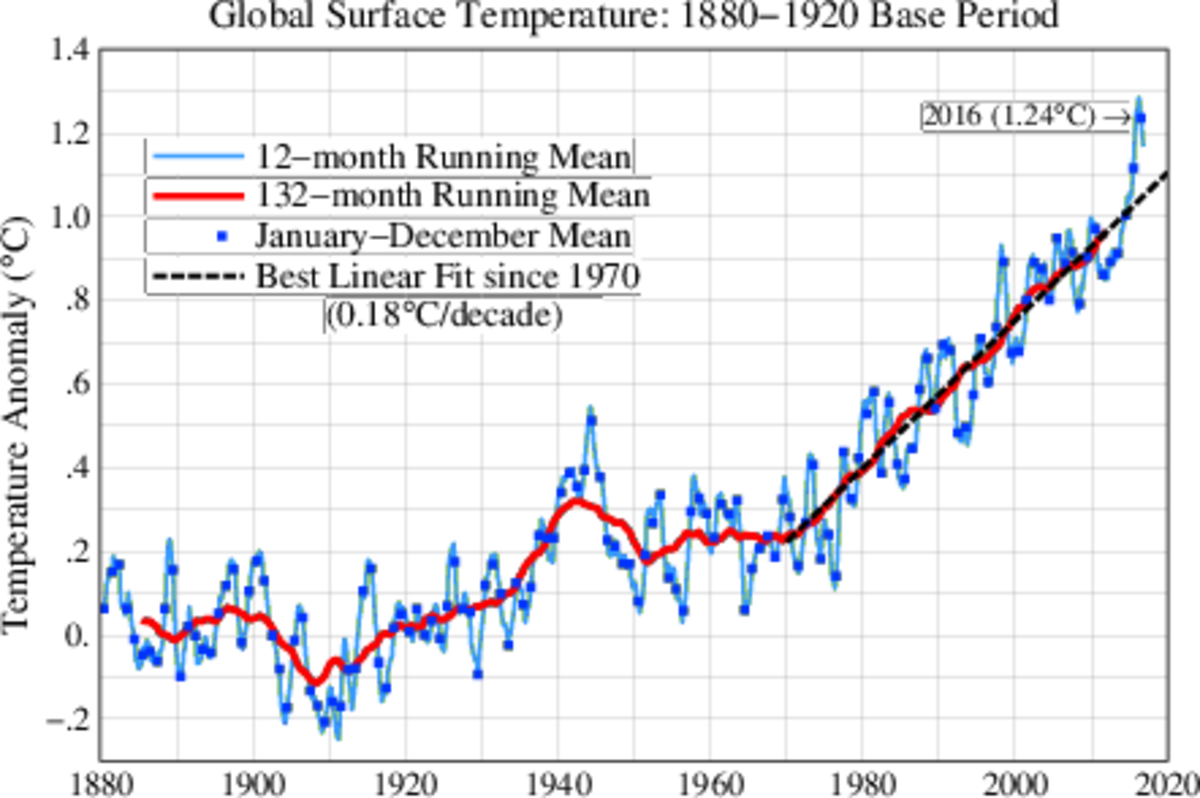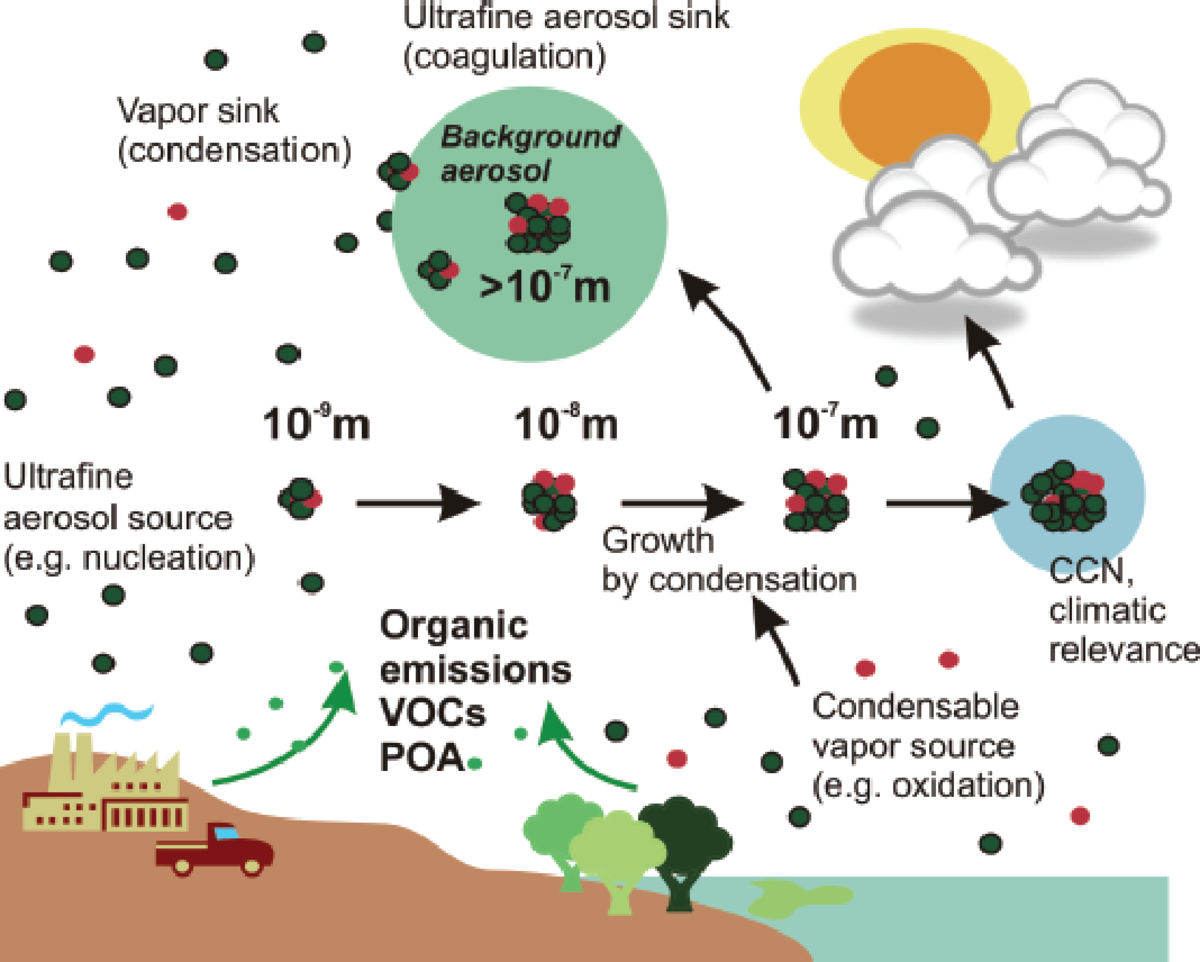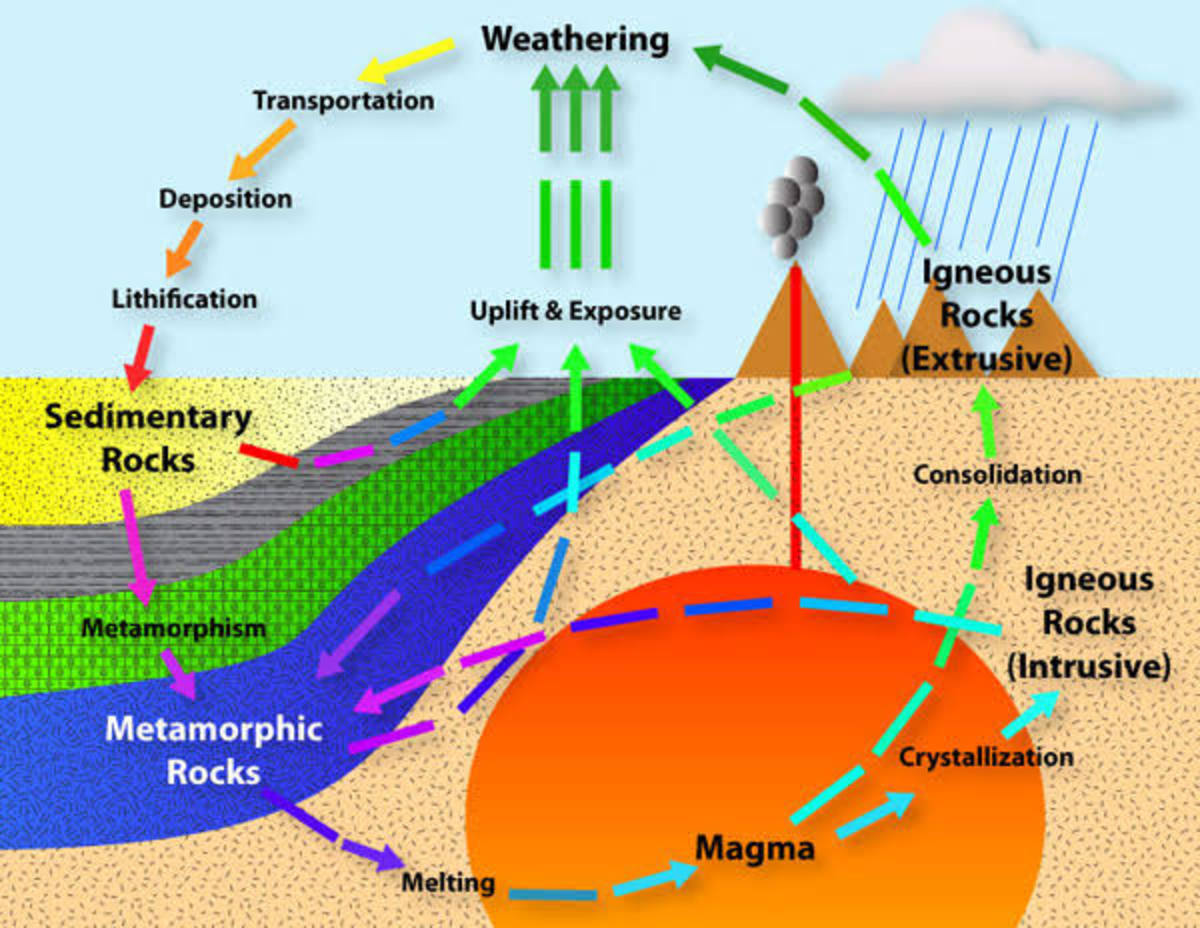CO2 Greenhouse Theory Topples Under Technical Scrutiny And Practical Testing
.
There are convincing arguments that the CO2 atmospheric greenhouse theory has no experimental foundation and no theoretical foundation.

Unstable Foundations?
In a previous HubPages article, ...Questioning The Greenhouse Theory – 2012 Review Of Gerlich And Tscheuschner ..., I discuss a 2007 paper by mathematical physicist, Gerhrard Gerlich and his co-author, Ralf D. Tscheuschner [Falsification Of The Atmospheric CO2 Greenhouse Effects Within The Frame Of Physics, ARXIV.ORG and INTERNATIONAL JOURNAL OF MODERN PHYSICS B, 23(3): 275-364].
In my article, I note the intense criticisms that Gerlich's and Tscheuschner's paper attracted, as well as the authors' thorough replies to these criticisms. I also post links to the original sources.
In the present HubPages article, I review the important points of Gerlich and Tscheuschner, and I introduce additional researchers who provide both experimental proof and theoretical proof that the CO2 atmospheric greenhouse effect does NOT exist. These researchers show deep understandings of the relevant sciences and mathematics, as they convince me that all arguments for human-caused global warming ignore reality.
The Experts And Their Findings
1. Gerhrard Gerlich [Institute Of Mathematical Physics, Federal Republic Of Germany] and Ralf D. Tscheuschner (2009). Falsification Of The Atmospheric CO2 Greenhouse Effects Within The Frame Of Physics, ARXIV.ORG and INTERNATIONAL JOURNAL OF MODERN PHYSICS B, 23(3): 275-364, http://arxiv.org/pdf/0707.1161)
- The atmospheric greenhouse effect essentially describes a fictitious mechanism.
- If a CO2 greenhouse gas warming effect existed, then it would show up in laboratory experiments (involving concentrated CO) as a thermal conductivity anomaly, manifesting itself as a new kind of “superinsulation” that violated the conventional heat conduction equation. Such CO2 anomalous heat transport properties, however, have never been observed.
- The atmospheric greenhouse mechanism is a conjecture, already disproved in concrete engineering thermodynamics by Alfred Schack, who wrote a classical textbook on the subject, and who (in 1972) showed that the radiative component of CO2 heat transfer, although relevant at the temperatures in combustion chambers, is negligible at atmospheric temperatures.
2. John Nicol, PhD, Professor Emeritus of Physics, James Cook University (2008). Climate Change: A Fundamental Analysis of the Greenhouse Effect, http://www.middlebury.net/nicol-08.doc
- The main process that results in warming the interior of a greenhouse is the removal of convection. Convection currents are among the most significant means of cooling the earth.
- The actual level of greenhouse gases in the atmosphere is almost of no consequence in determining the increase in surface temperature from the Greenhouse effect.
- At no stage are all of the Greenhouse gas molecules in a state of excitation. Any increase in that gas density will only reduce the height above the earth at which radiation is absorbed – it will not alter the total number of molecules in this upper state and hence have no effect on the proportion of radiation in the frequency range of a transparent atmosphere. Because of this transparency, the height at which the process takes place will have no bearing on the proportion, or amount, of radiation returned to the earth.
- Any gas with an absorption line or band lying within the spectral range of the radiation field from the warmed earth will be capable of contributing towards raising the temperature of the earth. After reaching a fixed threshold, however, of so-called Greenhouse gas density (much lower than currently found in the atmosphere), there will be no further increase in temperature from this source, no matter how large the increase in the atmospheric density of such gases.
3. Nasif S. Nahle (2011). Repeatability Of Professor Robert W. Wood’s 1909 Experiment On The Theory Of The Greenhouse, BIOLOGY CABINET ONLINE-ACADEMIC RESOURCES AND PRINCIPIA SCIENTIFIC INTERNATIONAL, http://www.biocab.org/Experiment_on_Greenhouses__Effect.pdf
(2010) The Total Emissivity Of Carbon Dioxide And Its Effect On The Tropospheric Temperature, BIOLOGY CABINET ONLINE-ACADEMIC RESOURCES AND PRINCIPIA SCIENTIFIC INTERNATIONAL, http://www.biocab.org/ECO2.pdf
- The experiment performed by Robert W. Wood in 1909 demonstrated that radiative heating does NOT warm greenhouses. Wood's experiment is unmistakably valid and systematically repeatable.
- The heating effect inside a greenhouse is due to blockage of convective heat exchange, and it neither relates to nor obeys any kind of “trapped radiation”.
- Carbon dioxide emitted by human activity cannot be the cause of climate change, since it is physically incapable of causing a significant change in the atmospheric temperature. Any assertion involving the physics of radiative heat transfer, where carbon dioxide is a causative agent of climate change, is a deliberate pseudoscientific misrepresentation.
4. Heinz Thieme (2010). The Thermodynamic Atmosphere Effect - Explained Stepwise, http://realplanet.eu/atmoseffect.htm
- Gravity essentially determines the temperature conditions within an atmosphere.
- The contribution of radiation absorption is of only subordinate importance to the average temperature in the atmosphere.
- Using traces of optically active gases alone to determine atmospheric temperatures is thermodynamic nonsense.
- Proportions of so-called "greenhouse gases" (CO2 mainly, O3, N2O, and CH4) have no significant effects on the temperatures at the ground level of an atmosphere. Atmospheric fluctuations in the concentrations of these gases, therefore, can have practically no effects.
5. Timothy Casey (2011), The Shattered Greenhouse: How Simple Physics Demolishes The "Greenhouse Effect", http://greenhouse.geologist-1011.net/
- In the real physics of thermodynamics, the measurable thermodynamic properties of common atmospheric gases predict little if any influence on temperature by carbon dioxide concentration. The inconsistency of temperature and carbon dioxide concentrations in the geological record confirm this prediction.
- When the back-radiation "Greenhouse Effect" hypothesis is put to a real, physical, material test, such as the Wood Experiment, there is no sign of it, because the "Greenhouse Effect" simply does not exist.
- Without the "Greenhouse Effect", how can anyone honestly describe global warming as "anthropogenic"?
Counterarguments To These Findings
As I point out in an earlier HubPages article, Gerlich and Tscheuschner originally attracted many critics, some of whom were thorough and seemingly decisive in refuting this duo’s claims. The strongest critics appear unified in believing that Gerlich and Tscheuschner lack basic understandings of thermodynamics, which seems farfetched, considering these experienced researchers' backgrounds in mathematical physics.
Jochen Ebel, who appeared to present a line-by-line refutation of Gerlich and Tscheuschner, complained that the two scientists failed to recognize relevant Einstein equations as “proof” of the CO2 greenhouse effect. John Nicol (Professor Emeritus of Physics from my list above), however, uses relevant Einstein equations precisely to prove that CO2 has insignificant effects on warming Earth’s atmosphere. Ebel and other critics seem to fail in addressing Gerlich’s and Tscheuschner’s most basic request, which is to produce a precise thermodynamic definition of the Greenhouse effect. Even Ebel, in his line-by-line dialectic dissection, and even with his impressive references to Einstein, does NOT produce such a thermodynamic definition. Instead, the critics seem to deflect readers back to the very literature on the Greenhouse effect that is under question.
In general, counterarguments can be elaborate and convincing because of their copious details alone, often involving as many attempts to discredit a person or a publication as attempts to clarify supposedly incorrect information. What remains most obvious is the passionate efforts put forth by both sides of the human-caused global warming debate that enable them both to prevail. The fact that two different sides CAN prevail convinces me that the science of human-caused global warming is definitely NOT settled.
A New Climate Paradigm
One of the most intelligent assessments of the CO2 greenhouse theory that I have found is:
6. Ned Nikolov, Ph.D. & Karl Zeller, Ph.D. (2011). Unified Theory of Climate: Expanding the Concept of Atmospheric Greenhouse Effect Using Thermodynamic Principles -- Implications for Predicting Future Climate Change, http://tallbloke.files.wordpress.com/2011/12/unified_theory_of_climate_poster_nikolov_zeller.pdf
- Thermodynamics tells us that it is not possible for a handful of trace gases (0.5% of atmospheric mass) to trap enough radiant heat to cause the significant thermal enhancement at Earth's surface claimed by the current greenhouse theory.
- Modern Global Climate Models do NOTsolve simultaneously for radiative transfer and CONVECTION. This failure to account for all actual heat transports is the mainreason the models project surface warming in response to rising atmospheric greenhouse gas concentrations. Consequently, CO2-driven global temperature forecasts are model artifacts!
- The atmosphere does NOT act as a blanket by reducing the surface infrared cooling to space, as maintained by the current Green House theory. Instead, the atmosphere itself, through pressure, is a sourceof extra energy.
- Chemical composition of an atmosphere affects average air density through the molecular mass of air, but chemical composition has NOimpact on the mean surface temperature.
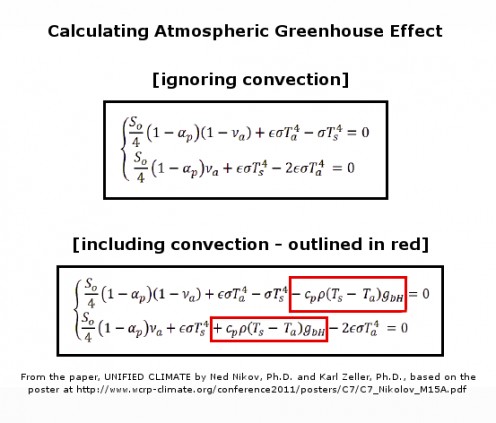
Faulty Formulas
A person does not need to understand the math, in order to understand that the math of current greenhouse gas calculations is missing critical elements. Similar to Nahle's findings, Nikolov's and Zeller's findings demonstrate precisely what these missing critical elements are.
Going back to Nahle for a moment, we learn that a standard formula for calculating CO2-induced temperature change:
"... fails to account for the sphericity of the system, the partial pressure of the absorbent gas and its buoyancy. Another problem with the formula is that it represents homogeneous values for the total emissivity and total absorptivity of the absorbent gas, which is absolutely at odds with what has been observed and verified through experimentation because the total emissivity and total absorptivity of any substance changes in proportion to its partial pressure in any given environment." (p.1 of Nahle's paper on emissivity)
The faulty formula to which Nahle refers appears below in an excerpt from his paper:
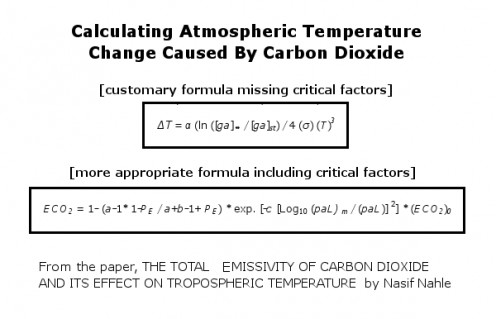
Now compare this to a highlighted excerpt from Nikolov's and Zeller's paper:
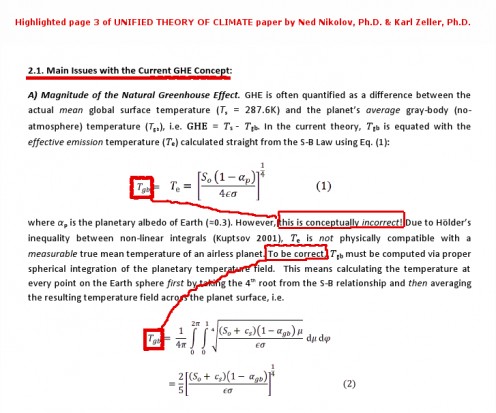
___________________________
Again, a person does NOT need to understand the math conceptually, in order to understand the problem visually. Merely notice FEWER terms in the POPULAR calculations, and observe MORE terms in the PROPER calculations.
The problem, then, is that popular calculations leave out critical mathematical terms that proper calculations should include.
Perhaps the greatest problem is that the present climate paradigm fails to take account of multiple forces working together simultaneously, harmonically, and collectively through different periods (both short-term and long-term).
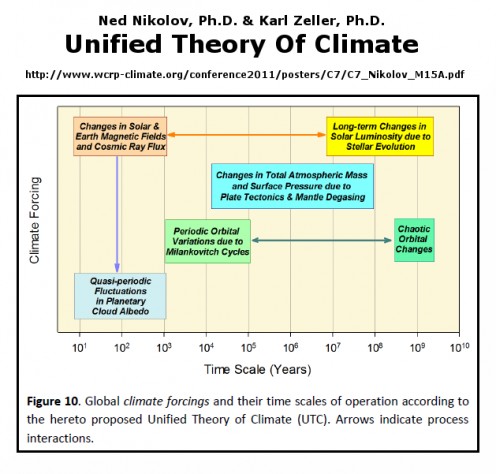
New Unified Theory Of Climate
As illustrated by the preceding photo, a new unified theory of climate would take account of the following forcings:
- Changes in solar and terrestrial magnetic fields and cosmic ray flux.
- Quasi-periodic fluctuations in planetary cloud albedo.
- Periodic orbital variations due to Milankovitch Cycles.
- Changes in total atmospheric mass and surface pressure due to plate tectonics and mantle degasing.
- Long-term changes in solar luminosity due to stellar evolution.
- Chaotic orbital changes.
A number of these forcings, of course, take place over periods far exceeding the age of the whole human race. Even so, the latest alterations in these extremely long-term forcings figure into the foundational conditions of the shorter-terrm forcings, which still exceed a single human life span manifold.
The immense time scale and true non-linear complexity of climate change, in fact, is what makes the present, linear obsession with the geological moment all the more anthropogenically self-indulgent.

